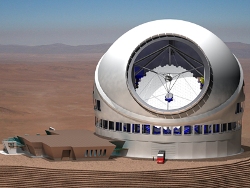Nov 18 2009
The National Astronomical Observatories of the Chinese Academy of Sciences (NAOC) has joined the Thirty Meter Telescope Project (TMT). As an Observer, China will participate in planning the development of what will be the world's most advanced and capable astronomical observatory.
"The TMT is delighted to take this exciting new step forward in our relationship with the National Astronomical Observatories of China," said Henry Yang, chairman of the TMT board and Chancellor of the University of California, Santa Barbara. "We appreciate their interest in contributing to this important international endeavor, and we look forward to continuing to work with the Chinese astronomical community in fostering China's collaboration in the TMT project."
 The Thirty Meter Observatory shown on the summit of one of the candidate sites
The Thirty Meter Observatory shown on the summit of one of the candidate sites
"We believe that the Thirty Meter Telescope will provide an otherwise unattainable opportunity for the Chinese astronomical community to make significant discoveries, perform cutting-edge science, and advance technological development," said Jun Yan, director of the NAOC. "We believe our joint effort will foster a successful collaboration on this world-class project, and we hope to build high-technology, core components of the telescope.”
“As the first step in a three stage process, Observer Status provides a framework for the detailed discussions needed to establish full partnership in the construction and operation of TMT,” according to Edward Stone, vice chair of the TMT board and Caltech’s Morrisroe Professor of Physics.
“We warmly welcome our Chinese colleagues, who will expand the international involvement in the Thirty Meter Telescope Project,” said Professor Ray Carlberg, the Canadian Large Optical Telescope project director and a TMT board member. “This new collaboration broadens the pool of talent and demonstrates the interest of national governments in TMT.”
When completed in 2018, the TMT will be the first of the next-generation of ground-based optical observatories. This revolutionary telescope will integrate the latest innovations in precision control, segmented mirror design, and adaptive optics to correct for the blurring effect of Earth's atmosphere. Building on the success of the twin Keck telescopes, the core technology of TMT will be a 30-meter segmented primary mirror. This will give TMT nine times the collecting area of today's largest optical telescopes and three times sharper images.
The TMT has begun full-scale polishing of the 1.4-meter mirror blanks that will make up the primary mirror. TMT also has developed many of the essential prototype components for the telescope, including key adaptive optics technologies and the support and control elements for the 492 mirror segments.
The TMT project has completed its $77 million design development phase with primary financial support of $50 million from the Gordon and Betty Moore Foundation and $22 million from Canada. The project has now entered the early construction phase thanks to an additional $200 million pledge from the Gordon and Betty Moore Foundation. Caltech and the University of California have agreed to raise matching funds of $50 million to bring the construction total to $300 million, and the Canadian partners propose to supply the enclosure, the telescope structure, and the first light adaptive optics.
The TMT project is an international partnership among the California Institute of Technology, the University of California, and the Association of Canadian Universities for Research in Astronomy. The National Astronomical Observatory of Japan (NAOJ) joined TMT as a Collaborating Institution in 2008.